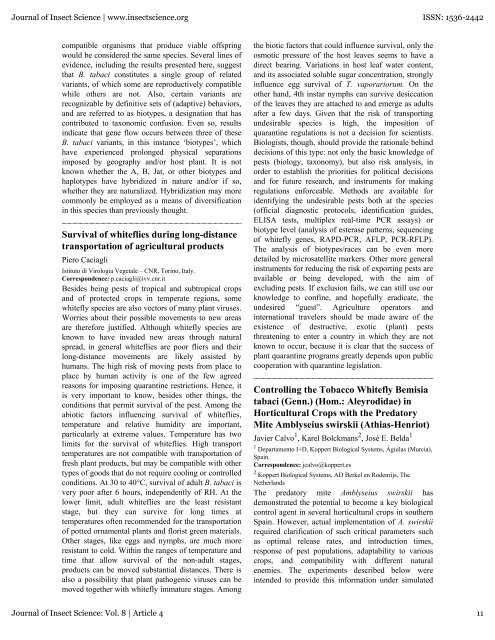Fourth International Bemisia Workshop International Whitefly ...
Fourth International Bemisia Workshop International Whitefly ...
Fourth International Bemisia Workshop International Whitefly ...
You also want an ePaper? Increase the reach of your titles
YUMPU automatically turns print PDFs into web optimized ePapers that Google loves.
Journal of Insect Science | www.insectscience.org ISSN: 1536-2442<br />
compatible organisms that produce viable offspring<br />
would be considered the same species. Several lines of<br />
evidence, including the results presented here, suggest<br />
that B. tabaci constitutes a single group of related<br />
variants, of which some are reproductively compatible<br />
while others are not. Also, certain variants are<br />
recognizable by definitive sets of (adaptive) behaviors,<br />
and are referred to as biotypes, a designation that has<br />
contributed to taxonomic confusion. Even so, results<br />
indicate that gene flow occurs between three of these<br />
B. tabaci variants, in this instance ‘biotypes’, which<br />
have experienced prolonged physical separations<br />
imposed by geography and/or host plant. It is not<br />
known whether the A, B, Jat, or other biotypes and<br />
haplotypes have hybridized in nature and/or if so,<br />
whether they are naturalized. Hybridization may more<br />
commonly be employed as a means of diversification<br />
in this species than previously thought.<br />
Survival of whiteflies during long-distance<br />
transportation of agricultural products<br />
Piero Caciagli<br />
Istituto di Virologia Vegetale – CNR, Torino, Italy.<br />
Correspondence: p.caciagli@ivv.cnr.it<br />
Besides being pests of tropical and subtropical crops<br />
and of protected crops in temperate regions, some<br />
whitefly species are also vectors of many plant viruses.<br />
Worries about their possible movements to new areas<br />
are therefore justified. Although whitefly species are<br />
known to have invaded new areas through natural<br />
spread, in general whiteflies are poor fliers and their<br />
long-distance movements are likely assisted by<br />
humans. The high risk of moving pests from place to<br />
place by human activity is one of the few agreed<br />
reasons for imposing quarantine restrictions. Hence, it<br />
is very important to know, besides other things, the<br />
conditions that permit survival of the pest. Among the<br />
abiotic factors influencing survival of whiteflies,<br />
temperature and relative humidity are important,<br />
particularly at extreme values. Temperature has two<br />
limits for the survival of whiteflies. High transport<br />
temperatures are not compatible with transportation of<br />
fresh plant products, but may be compatible with other<br />
types of goods that do not require cooling or controlled<br />
conditions. At 30 to 40°C, survival of adult B. tabaci is<br />
very poor after 6 hours, independently of RH. At the<br />
lower limit, adult whiteflies are the least resistant<br />
stage, but they can survive for long times at<br />
temperatures often recommended for the transportation<br />
of potted ornamental plants and florist green materials.<br />
Other stages, like eggs and nymphs, are much more<br />
resistant to cold. Within the ranges of temperature and<br />
time that allow survival of the non-adult stages,<br />
products can be moved substantial distances. There is<br />
also a possibility that plant pathogenic viruses can be<br />
moved together with whitefly immature stages. Among<br />
the biotic factors that could influence survival, only the<br />
osmotic pressure of the host leaves seems to have a<br />
direct bearing. Variations in host leaf water content,<br />
and its associated soluble sugar concentration, strongly<br />
influence egg survival of T. vaporariorum. On the<br />
other hand, 4th instar nymphs can survive desiccation<br />
of the leaves they are attached to and emerge as adults<br />
after a few days. Given that the risk of transporting<br />
undesirable species is high, the imposition of<br />
quarantine regulations is not a decision for scientists.<br />
Biologists, though, should provide the rationale behind<br />
decisions of this type: not only the basic knowledge of<br />
pests (biology, taxonomy), but also risk analysis, in<br />
order to establish the priorities for political decisions<br />
and for future research, and instruments for making<br />
regulations enforceable. Methods are available for<br />
identifying the undesirable pests both at the species<br />
(official diagnostic protocols, identification guides,<br />
ELISA tests, multiplex real-time PCR assays) or<br />
biotype level (analysis of esterase patterns, sequencing<br />
of whitefly genes, RAPD-PCR, AFLP, PCR-RFLP).<br />
The analysis of biotypes/races can be even more<br />
detailed by microsatellite markers. Other more general<br />
instruments for reducing the risk of exporting pests are<br />
available or being developed, with the aim of<br />
excluding pests. If exclusion fails, we can still use our<br />
knowledge to confine, and hopefully eradicate, the<br />
undesired “guest”. Agriculture operators and<br />
international travelers should be made aware of the<br />
existence of destructive, exotic (plant) pests<br />
threatening to enter a country in which they are not<br />
known to occur, because it is clear that the success of<br />
plant quarantine programs greatly depends upon public<br />
cooperation with quarantine legislation.<br />
Controlling the Tobacco <strong>Whitefly</strong> <strong>Bemisia</strong><br />
tabaci (Genn.) (Hom.: Aleyrodidae) in<br />
Horticultural Crops with the Predatory<br />
Mite Amblyseius swirskii (Athias-Henriot)<br />
Javier Calvo 1 , Karel Bolckmans 2 , José E. Belda 1<br />
1 Departamento I+D, Koppert Biological Systems, Águilas (Murcia),<br />
Spain.<br />
Correspondence: jcalvo@koppert.es<br />
2 Koppert Biological Systems, AD Berkel en Rodenrijs, The<br />
Netherlands<br />
The predatory mite Amblyseius swirskii has<br />
demonstrated the potential to become a key biological<br />
control agent in several horticultural crops in southern<br />
Spain. However, actual implementation of A. swirskii<br />
required clarification of such critical parameters such<br />
as optimal release rates, and introduction times,<br />
response of pest populations, adaptability to various<br />
crops, and compatibility with different natural<br />
enemies. The experiments described below were<br />
intended to provide this information under simulated<br />
Journal of Insect Science: Vol. 8 | Article 4 11
















